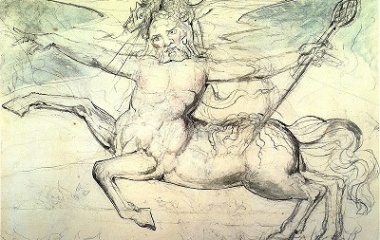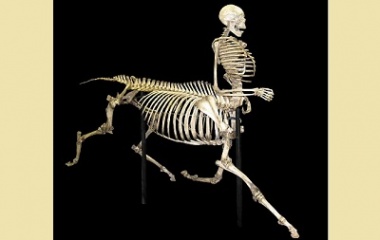What is a Centaur?
Centaurs are ancient Greek chimeras, half-man and half-horse. With the exception of a few superior individuals, they live in a savage way and often lash out against civilization.
Characteristics
Physical Description
Centaurs are defined by a blend of human and horse characteristics, but this blend can take a number of different shapes. The most common chimeric variety is a man’s head and torso, melding into a horse’s body, where the neck would be, and terminating in four finely sculpted horse’s legs. Others have a full human body, with the hindquarters of a horse sprouting from their hips to furnish two extra legs and a long, silky tail.
Because Centaurs make their home on the rugged slopes of Mount Pelion or in the isolated forests of Cyprus, they carry an air of wilderness with them. Their ears are pointed, their hair unruly, and their skin browned by the sun. Although they often sling a bow and a quiver of arrows over their shoulders, they don’t wear any clothing. A few tribes, especially around Cyprus and Lamos, have horns like a goat or a bull.
Special Abilities
Early on, the Centaurs lived a savage, artless lifestyle. They made crude homes in caves, foraged for berries and nuts, and hunted wild animals with spears and stones as weapons. Their strength and careless bravery made them frightening enemies, but they had no real talent or sophistication beyond this.
Still, a handful of Centaurs rose above their beast-like brothers to become allies of the Greek heroes and gods. Chiron is, by far, the most notable. He was a marvelous teacher who took many of Greece’s finest heroes under his wing, as well as a warrior, a medical genius, and a prophet. Likewise, a group of twelve Centaurs, called the “Lamian Pheres” had a gentle, helpful nature. They raised the god Dionysus in secret and, after he was a grown man, pulled his chariot for him and accompanied him into battle.
Related Creatures
Most of the Centaurs were born to Ixion, king of the Lapiths, and Nephele, a cloud that looked like Hera. Zeus made this strange pregnancy possible when his wife, Hera, complained to him that Ixion was in love with her and planned to break into her bed chamber at night. Skeptical of this extraordinary claim, Zeus created Nephele and sent her to Hera’s bed chamber, to see if Ixion would show up. Sure enough, the king appeared by night and slept with Nephele, whom he mistook for Hera. Zeus was enraged by Ixion’s boldness. He ordered the king to be strapped to a wheel in the heavens and spun around and around as punishment. Meanwhile, Nephele escaped to earth and gave birth to the Centaur race.
Chiron and the Lamian Pheres had a diferent parentage, which might explain their superiority over the others. Chiron was born to two Titans: Cronus and Philyra. Unfortunately, his parents were horrified when they saw his chimeric form, and they abandoned him at birth. Apollo and Artemis took pity on the orphan and raised him, teaching him their skills and the rules of civilization. The Lamian Pheres were a group of rustic demigods before they agreed to protect the baby Dionysus for Zeus, his father. When Hera found out that the Lamians were protecting her husband’s illegitimate son, she lashed out against them, transforming them into monstrous chimeras.
Cultural Representation
Origin
Centaurs have stamped their hoofprints on some of the earliest Greek tales. They first appear in Homer’s Odyssey and Iliad, which date back to the 8th century BC, and they continue to pop up in Ovid, Hesiod, and Virgil’s epic writing. At the turn of the 1st century AD, they were scrutinized by one of the world’s first naturalists: Pliny the Elder.
Famous Myths
The creation of Centaurs, as mentioned above, is one of the most popular stories about them. It has been re-told by several Greek and Roman scholars, including Pindar and Cicero.
The Centaurs’ strange lineage eventually led to their involvement in another popular story: the battle of the Lapiths. Despite their savage habits, they were invited to attend the wedding of their half-brother, Pirithous, who was another son of Ixion and the new king of Lapiths. At this wedding, the rustic creatures tasted a wine much richer than the poor drinks they made in their caves. They were quickly intoxicated, and they decided to carry some of the elegant women of Lapiths (who were, again, much finer than anything they had seen before) back to their caves. They even attempted to snatch up Pirithous’ bride! Naturally, a fight broke out. The raucous Centaurs used anything they could find for weapons, from heavy rocks to decorative antler displays. However, the Lapiths men had fine armor and weapons made of silver and gold. They eventually won the battle, killing many of the Centaurs.
Another important myth relates to Chiron who, being un-related to Ixion, did not appear at the battle of Lapiths. Chiron was a noble, immortal creature. Still, after training dozens of heroes, he met a painful death. One of his beloved students, Heracles, had brought a new weapon for Chiron to examine: a spear poisoned by the blood of Medusa. The spear accidentally struck Chiron in the hoof, and he was immediately wracked with pain from the poison. As an immortal, he could not die, even though he was in horrible pain, so he had to come up with a creative way to exit the world. He offered his life to Zeus, but in exchange, he asked the king of the gods to allow Heracles to free Prometheus. This sacrifice was accepted, and Chiron passed into the stars as a constellation.
Modern Usage
Centaurs have stood the test of time, proving to be one of Greece’s most inspiring inventions. They continue to haunt the forests of today’s fantasy novels.
In JK Rowling’s Harry Potter series, a tribe of Centaur lived in the Forbidden Forest, right outside the magical school of Hogwarts. Rowling’s creatures were highly territorial and protective of their home. They carried heavy spears, which they used to drive away anyone who wandered into their forest. They were also talented oracles, able to read the future in the stars.
In CS Lewis’ Chronicles of Narnia, Centaurs appeared as wise prophets and brilliant military strategists. With once glance at the stars, they could predict the outcome of a battle and make necessary adjustments. Some of them were also trained in the art of healing.
In Disney’s movie Fantasia Centaurs can be seen helping the god Dionysus make (and drink) wine by the barrel.










